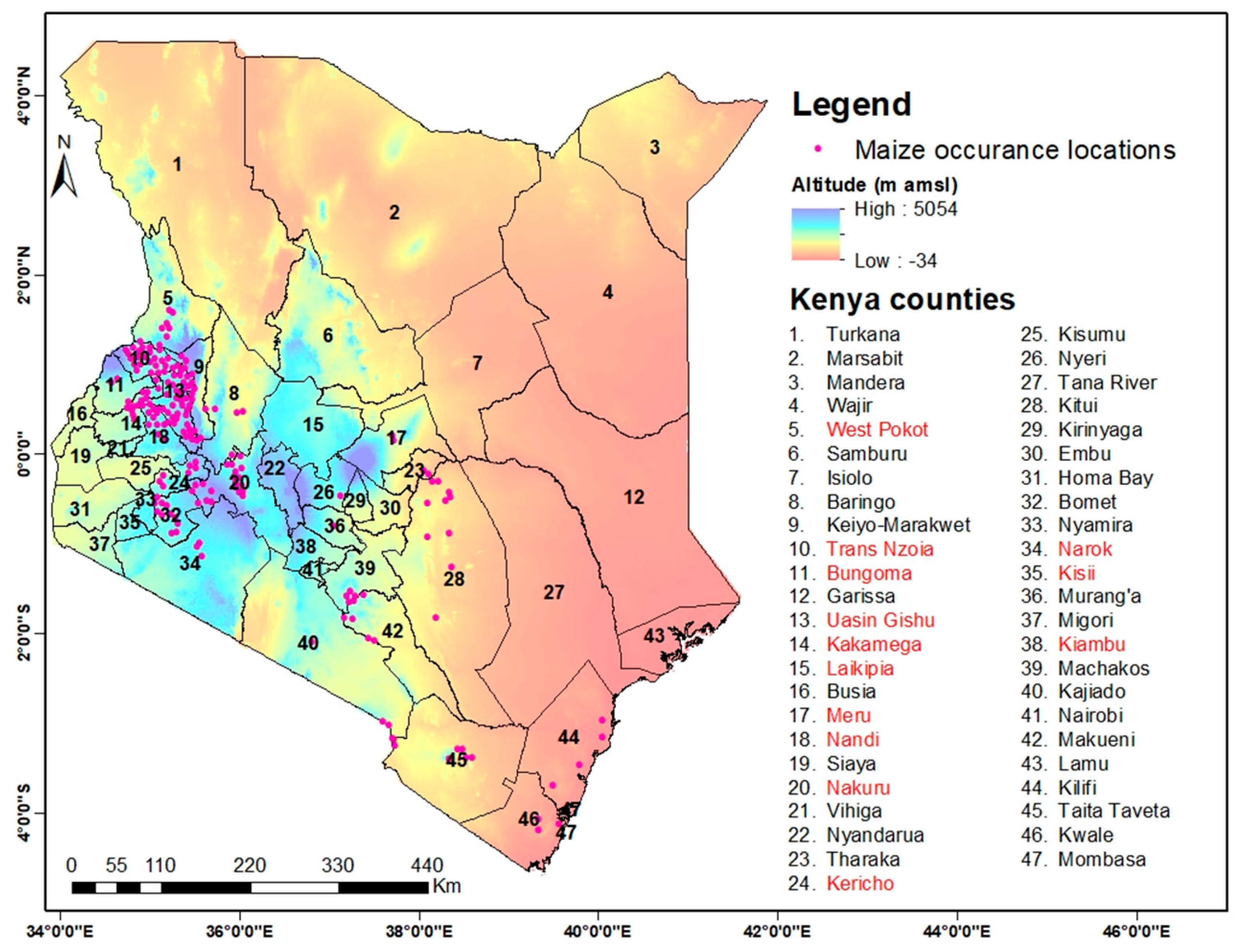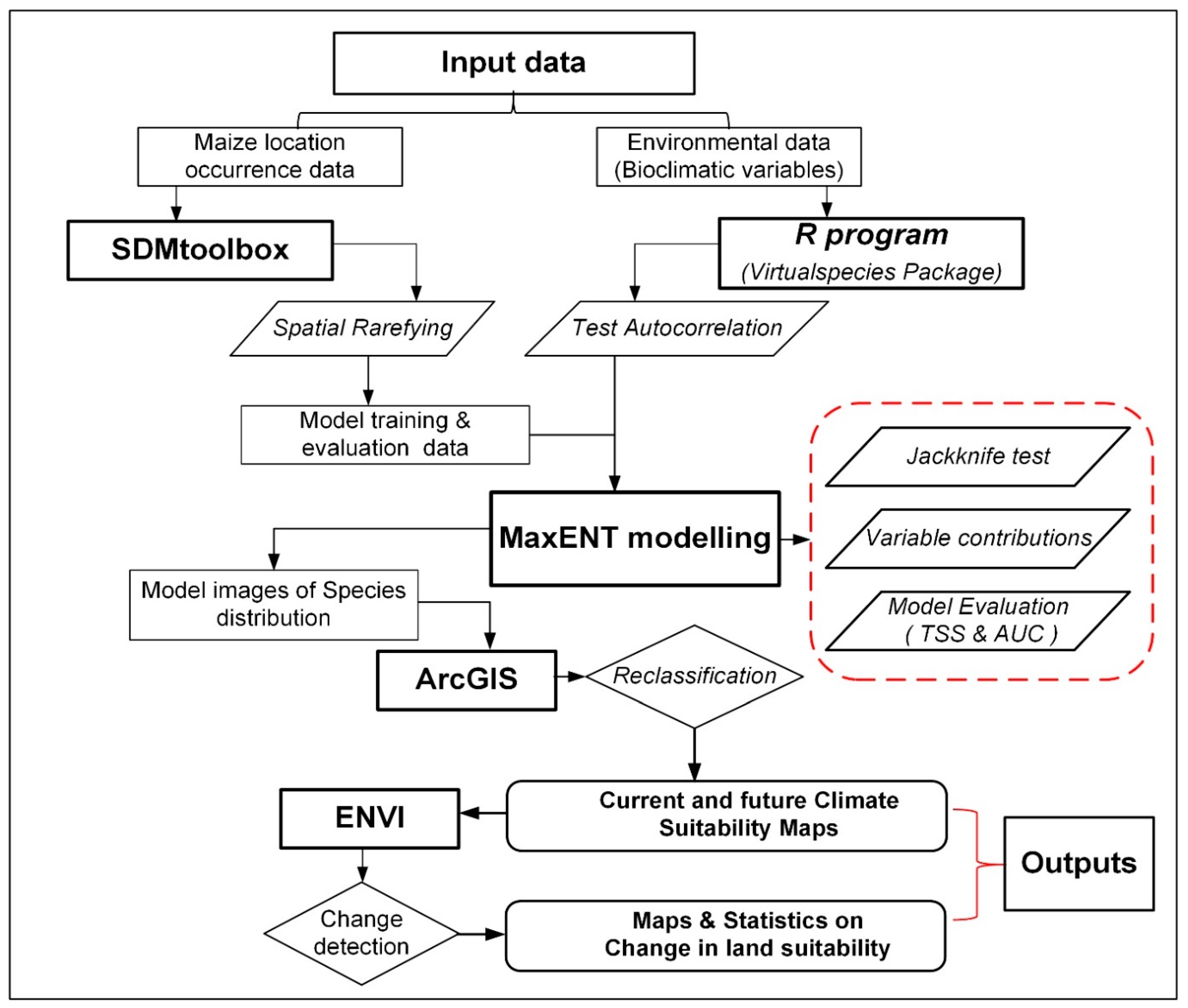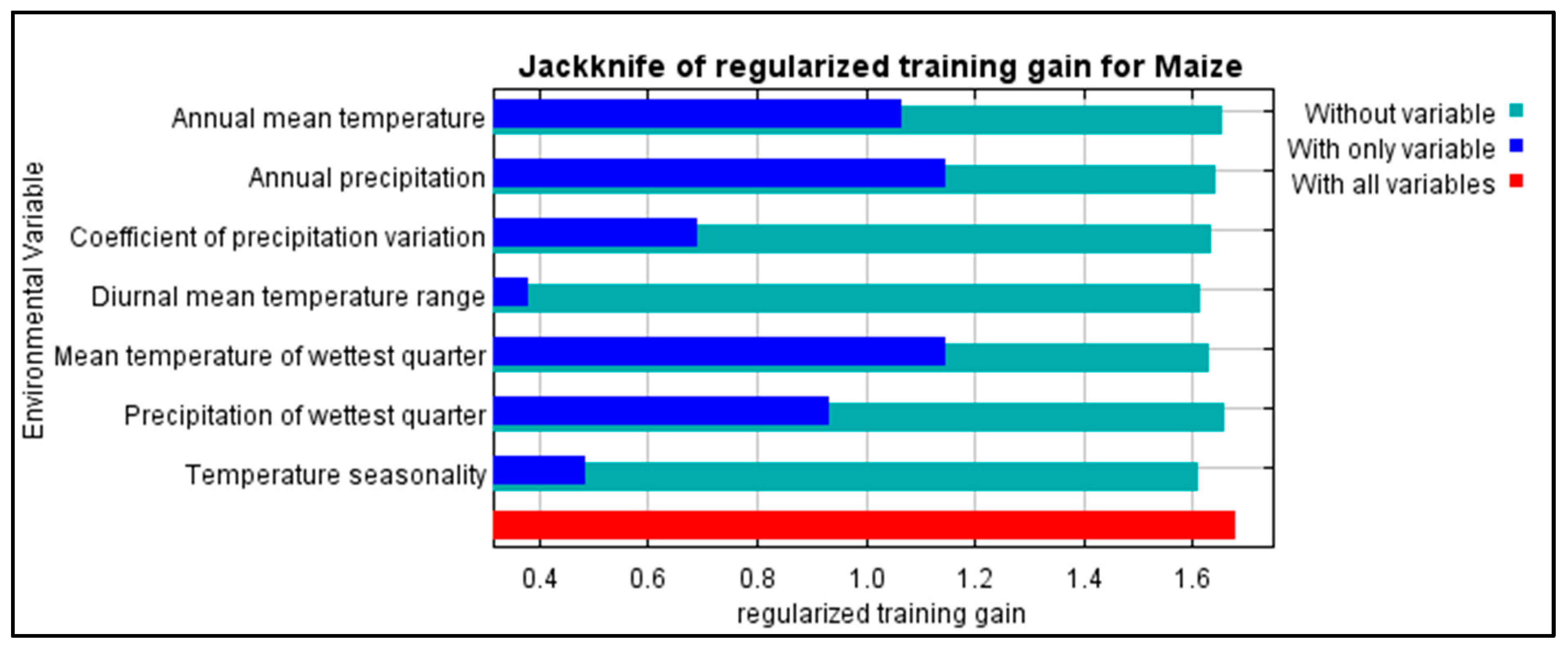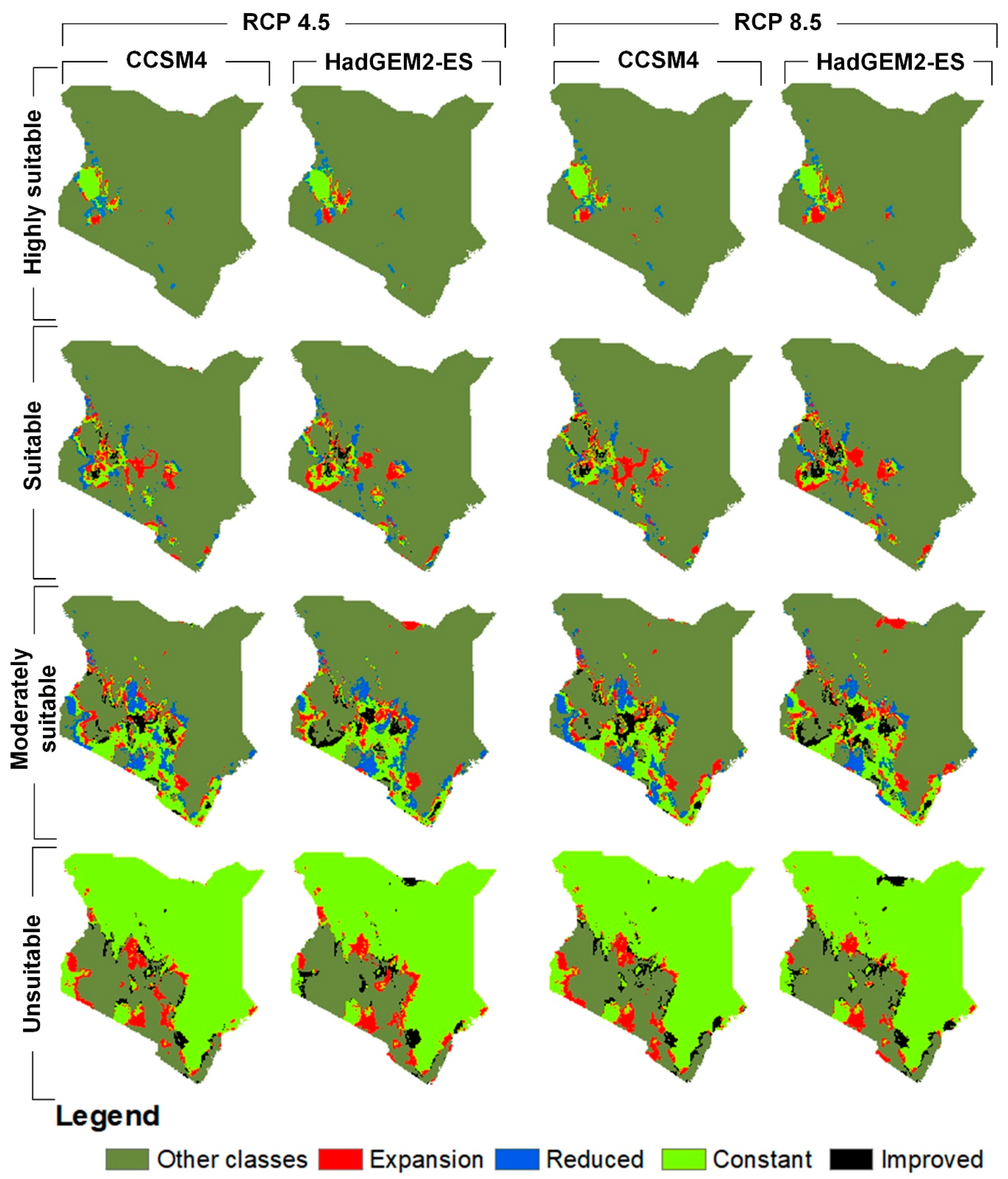Modelling Climate Suitability for Rainfed Maize Cultivation in Kenya Using a Maximum Entropy (MaxENT) Approach
Abstract
:1. Introduction
2. Materials and Methods
2.1. Study Area
2.2. Environmental Modelling Data
2.3. Species Occurrence Data
2.4. Ecological Niche Modelling
2.5. MaxEnt Settings and Evaluation of Model Accuracy
2.6. Reclassification and Change Detection
3. Results
3.1. Climatic Variables Influencing Land Suitability for Maize Cultivation
3.2. Model Performance
3.3. Suitability Zones for Maize Production
3.4. Change in Suitability for Maize Production
4. Discussion
5. Conclusions
Supplementary Materials
Author Contributions
Funding
Acknowledgments
Conflicts of Interest
References
- Bennetzen, E.H.; Smith, P.; Porter, J.R. Agricultural production and greenhouse gas emissions from world regions—The major trends over 40 years. Glob. Environ. Chang. 2016, 37, 43–55. [Google Scholar] [CrossRef]
- Godfray, H.C.J.; Crute, I.R.; Haddad, L.; Lawrence, D.; Muir, J.F.; Nisbett, N.; Pretty, J.; Robinson, S.; Toulmin, C.; Whiteley, R. The future of the global food system. Philos. Trans. R. Soc. Lond. B Biol. Sci. 2010, 365, 2769–2777. [Google Scholar] [CrossRef] [PubMed] [Green Version]
- IPCC. Climate Change 2014: Impacts, Adaptation, and Vulnerability. Part B: Regional Aspects. Contribution of Working Group II to the Fifth Assessment Report of the Intergovernmental Panel on Climate Change; Barros, V.R., Field, C.B., Dokken, D.J., Mastrandrea, M.D., Mach, K.J., Bilir, T.E., Chatterjee, M., Ebi, K.L., Estrada, Y.O., Genova, R.C., et al., Eds.; IPCC: Geneva, Switzerland, 2014; p. 688. [Google Scholar]
- Khan, Z.; Pickett, J.; Wadhams, L.; Muyekho, F. Habitat management strategies for the control of cereal stemborers and striga in maize in Kenya. Int. J. Trop. Insect Sci. 2001, 21, 375–380. [Google Scholar] [CrossRef]
- Zabel, F.; Putzenlechner, B.; Mauser, W. Global agricultural land resources–a high resolution suitability evaluation and its perspectives until 2100 under climate change conditions. PLoS ONE 2014, 9, e107522. [Google Scholar] [CrossRef] [PubMed]
- Zhang, Y.; Wang, Y.; Niu, H. Spatio-temporal variations in the areas suitable for the cultivation of rice and maize in China under future climate scenarios. Sci. Total Environ. 2017, 601, 518–531. [Google Scholar] [CrossRef]
- Byeon, D.-H.; Jung, S.; Lee, W.-H. Review of CLIMEX and MaxEnt for studying species distribution in South Korea. J. Asia-Pac. Biodivers. 2018, 11, 325–333. [Google Scholar] [CrossRef]
- Fourcade, Y.; Engler, J.O.; Rödder, D.; Secondi, J. Mapping species distributions with MAXENT using a geographically biased sample of presence data: A performance assessment of methods for correcting sampling bias. PLoS ONE 2014, 9, e97122. [Google Scholar] [CrossRef]
- Remya, K.; Ramachandran, A.; Jayakumar, S. Predicting the current and future suitable habitat distribution of Myristica dactyloides Gaertn. using MaxEnt model in the Eastern Ghats, India. Ecol. Eng. 2015, 82, 184–188. [Google Scholar] [CrossRef]
- Hossell, J.; Ellis, N.; Harley, M.; Hepburn, I. Climate change and nature conservation: Implications for policy and practice in Britain and Ireland. J. Nat. Conserv. 2003, 11, 67–73. [Google Scholar] [CrossRef]
- Lamsal, P.; Kumar, L.; Aryal, A.; Atreya, K. Invasive alien plant species dynamics in the Himalayan region under climate change. Ambio 2018, 47, 697–710. [Google Scholar] [CrossRef]
- Austin, M. Spatial prediction of species distribution: An interface between ecological theory and statistical modelling. Ecol. Model. 2002, 157, 101–118. [Google Scholar] [CrossRef]
- Segurado, P.; Araujo, M.B. An evaluation of methods for modelling species distributions. J. Biogeogr. 2004, 31, 1555–1568. [Google Scholar] [CrossRef]
- Elith, J.; Graham, C.H.; Anderson, R.P.; Dudík, M.; Ferrier, S.; Guisan, A.; Hijmans, R.J.; Huettmann, F.; Leathwick, J.R.; Lehmann, A. Novel methods improve prediction of species’ distributions from occurrence data. Ecography 2006, 29, 129–151. [Google Scholar] [CrossRef]
- Beaumont, L.J.; Hughes, L.; Poulsen, M. Predicting species distributions: Use of climatic parameters in BIOCLIM and its impact on predictions of species’ current and future distributions. Ecol. Model. 2005, 186, 251–270. [Google Scholar] [CrossRef]
- Shabani, F.; Kumar, L.; Taylor, S. Climate change impacts on the future distribution of date palms: A modeling exercise using CLIMEX. PLoS ONE 2012, 7, e48021. [Google Scholar] [CrossRef]
- Kariyawasam, C.S.; Kumar, L.; Ratnayake, S.S. Invasive Plant Species Establishment and Range Dynamics in Sri Lanka under Climate Change. Entropy 2019, 21, 571. [Google Scholar] [CrossRef]
- He, Q.J.; Zhou, G.S. Climate-associated distribution of summer maize in China from 1961 to 2010. Agric. Ecosyst. Environ. 2016, 232, 326–335. [Google Scholar] [CrossRef]
- Jayasinghe, S.L.; Kumar, L. Modeling the climate suitability of tea [Camellia sinensis (L.) O. Kuntze] in Sri Lanka in response to current and future climate change scenarios. Agric. For. Meteorol. 2019, 272, 102–117. [Google Scholar] [CrossRef]
- Duan, J.; Zhou, G. Climatic suitability of double rice planting regions in China. Sci. Agric. Sin. 2012, 45, 218–227. [Google Scholar]
- Liu, Z.; Yang, P.; Tang, H.; Wu, W.; Zhang, L.; Yu, Q.; Li, Z. Shifts in the extent and location of rice cropping areas match the climate change pattern in China during 1980–2010. Reg. Environ. Chang. 2015, 15, 919–929. [Google Scholar] [CrossRef]
- Davis, A.P.; Gole, T.W.; Baena, S.; Moat, J. The impact of climate change on indigenous arabica coffee (Coffea arabica): Predicting future trends and identifying priorities. PLoS ONE 2012, 7, e47981. [Google Scholar] [CrossRef] [PubMed]
- Garcia, K.; Lasco, R.; Ines, A.; Lyon, B.; Pulhin, F. Predicting geographic distribution and habitat suitability due to climate change of selected threatened forest tree species in the Philippines. Appl. Geogr. 2013, 44, 12–22. [Google Scholar] [CrossRef]
- Beck, J. Predicting climate change effects on agriculture from ecological niche modeling: Who profits, who loses? Clim. Chang. 2013, 116, 177–189. [Google Scholar] [CrossRef]
- GoK. Government of Kenya Adaptation Technical Analysis Report; Climate and Development Knowledge Network (CDKN): Nairobi, Kenya, 2012. [Google Scholar]
- GoK. Agricultural Sector Development Strategy, 2010–2020; Government of Kenya: Nairobi, Kenya, 2010.
- Sombroek, W.G.; Braun, H.; Van der Pouw, B. Exploratory soil Map and Agro-Climatic Zone Map of Kenya, 1980. Scale 1: 1,000,000; Kenya Soil Survey: Nairobi, Kenya, 1982. [Google Scholar]
- Mati, B.M. The influence of climate change on maize production in the semi-humid–semi-arid areas of Kenya. J. Arid Environ. 2000, 46, 333–344. [Google Scholar] [CrossRef]
- WorldClim Home Page. Available online: http://worldclim.org/version2 (accessed on 20 February 2019).
- Hijmans, R.J.; Cameron, S.E.; Parra, J.L.; Jones, P.G.; Jarvis, A. Very high resolution interpolated climate surfaces for global land areas. Int. J. Climatol. A J. R. Meteorol. Soc. 2005, 25, 1965–1978. [Google Scholar] [CrossRef]
- Dike, V.N.; Shimizu, M.H.; Diallo, M.; Lin, Z.; Nwofor, O.K.; Chineke, T.C. Modelling present and future African climate using CMIP5 scenarios in HadGEM2-ES. Int. J. Climatol. 2015, 35, 1784–1799. [Google Scholar] [CrossRef]
- Gent, P.R.; Danabasoglu, G.; Donner, L.J.; Holland, M.M.; Hunke, E.C.; Jayne, S.R.; Lawrence, D.M.; Neale, R.B.; Rasch, P.J.; Vertenstein, M. The community climate system model version 4. J. Clim. 2011, 24, 4973–4991. [Google Scholar] [CrossRef]
- Fer, I.; Tietjen, B.; Jeltsch, F.; Wolff, C. The Influence of El Nino-Southern Oscillation Regimes on Eastern African Vegetation and Its Future Implications under the RCP8. 5 Warming Scenario. Biogeosciences 2017, 14, 4355–4374. [Google Scholar] [CrossRef]
- Dormann, C.F.; Elith, J.; Bacher, S.; Buchmann, C.; Carl, G.; Carré, G.; Marquéz, J.R.G.; Gruber, B.; Lafourcade, B.; Leitão, P.J. Collinearity: A review of methods to deal with it and a simulation study evaluating their performance. Ecography 2013, 36, 27–46. [Google Scholar] [CrossRef]
- Brown, J.L. SDM toolbox: A python-based GIS toolkit for landscape genetic, biogeographic and species distribution model analyses. Methods Ecol. Evol. 2014, 5, 694–700. [Google Scholar] [CrossRef]
- Phillips, S.J.; Anderson, R.P.; Schapire, R.E. Maximum entropy modeling of species geographic distributions. Ecol. Model. 2006, 190, 231–259. [Google Scholar] [CrossRef] [Green Version]
- FAOSTAT Home Page. Available online: http://www.fao.org/faostat/en/#data/QC (accessed on 25 February 2019).
- ICPAC Geoportal Home Page. Available online: http://geoportal.icpac.net/layers/geonode%3 Akenya_croplands_2015 (accessed on 15 September 2019).
- Veloz, S.D. Spatially autocorrelated sampling falsely inflates measures of accuracy for presence-only niche models. J. Biogeogr. 2009, 36, 2290–2299. [Google Scholar] [CrossRef]
- Steven, J. Phillips. 2007. Maxent Software for Modelling Species Niches and Distributions. Available online: http://biodiversityinformatics.amnh.org/open_source/maxent/ (accessed on 15 February 2019).
- Graham, C.H.; Elith, J.; Hijmans, R.J.; Guisan, A.; Townsend Peterson, A.; Loiselle, B.A.; NCEAS Species Distribution Modeling Group. The influence of spatial errors in species occurrence data used in distribution models. J. Appl. Ecol. 2008, 45, 239–247. [Google Scholar] [CrossRef]
- Merow, C.; Smith, M.J.; Silander, J.A., Jr. A practical guide to MaxEnt for modeling species’ distributions: What it does, and why inputs and settings matter. Ecography 2013, 36, 1058–1069. [Google Scholar] [CrossRef]
- Zaniewski, A.E.; Lehmann, A.; Overton, J.M. Predicting species spatial distributions using presence-only data: A case study of native New Zealand ferns. Ecol. Model. 2002, 157, 261–280. [Google Scholar] [CrossRef]
- A MaxEnt model v3. 3.3 e Tutorial (ArcGIS v10). Available online: https://www.coloradoview.org/wp-content/coloradoviewData/trainingData/a-maxent-model-v8.pdf (accessed on 25 March 2019).
- Allouche, O.; Tsoar, A.; Kadmon, R. Assessing the accuracy of species distribution models: Prevalence, kappa and the true skill statistic (TSS). J. Appl. Ecol. 2006, 43, 1223–1232. [Google Scholar] [CrossRef]
- Mason, S.J.; Graham, N.E. Areas beneath the relative operating characteristics (ROC) and relative operating levels (ROL) curves: Statistical significance and interpretation. Q. J. R. Meteorol. Soc. 2002, 128, 2145–2166. [Google Scholar] [CrossRef]
- Gavilán, R.G. The use of climatic parameters and indices in vegetation distribution. A case study in the Spanish Sistema Central. Int. J. Biometeorol. 2005, 50, 111–120. [Google Scholar] [CrossRef]
- Klein, F.; Goosse, H.; Graham, N.E.; Verschuren, D. Comparison of simulated and reconstructed variations in East African hydroclimate over the last millennium. Clim. Past 2016, 12. [Google Scholar] [CrossRef]
- Ogutu, G.E.O.; Franssen, W.H.P.; Supit, I.; Omondi, P.; Hutjes, R.W.A. Probabilistic maize yield prediction over East Africa using dynamic ensemble seasonal climate forecasts. Agric. For. Meteorol. 2018, 250, 243–261. [Google Scholar] [CrossRef]
- Olson, J.M.; Alagarswamy, G.; Andresen, J.A.; Campbell, D.J.; Davis, A.Y.; Ge, J.; Huebner, M.; Lofgren, B.M.; Lusch, D.P.; Moore, N.J. Integrating diverse methods to understand climate–land interactions in East Africa. Geoforum 2008, 39, 898–911. [Google Scholar] [CrossRef]
- Sun, J.; Cheng, G.; Li, W. Meta-analysis of relationships between environmental factors and aboveground biomass in the alpine grassland on the Tibetan Plateau. Biogeosciences 2013, 10, 1707–1715. [Google Scholar] [CrossRef] [Green Version]
- Woodward, F.I. Climate and Plant Distribution; Cambridge University Press: Cambridge, UK, 1987. [Google Scholar]
- Fielding, A.H.; Bell, J.F. A review of methods for the assessment of prediction errors in conservation presence/absence models. Environ. Conserv. 1997, 24, 38–49. [Google Scholar] [CrossRef]
- Peterson, A.T.; Soberón, J.; Pearson, R.G.; Anderson, R.P.; Martínez-Meyer, E.; Nakamura, M.; Araújo, M.B. Ecological Niches and Geographic Distributions (MPB-49); Princeton University Press: Princeton, NJ, USA, 2011; Volume 56. [Google Scholar]
- Pearce, J.; Ferrier, S. Evaluating the predictive performance of habitat models developed using logistic regression. Ecol. Model. 2000, 133, 225–245. [Google Scholar] [CrossRef] [Green Version]
- Pramanik, M.; Paudel, U.; Mondal, B.; Chakraborti, S.; Deb, P. Predicting climate change impacts on the distribution of the threatened Garcinia indica in the Western Ghats, India. Clim. Risk Manag. 2018, 19, 94–105. [Google Scholar] [CrossRef]
- Machovina, B.; Feeley, K.J. Climate change driven shifts in the extent and location of areas suitable for export banana production. Ecol. Econ. 2013, 95, 83–95. [Google Scholar] [CrossRef]
- Ji, Y.H.; Zhou, G.S.; He, Q.J.; Wang, L.X. The Effect of Climate Change on Spring Maize (Zea mays L.) Suitability across China. Sustainability 2018, 10, 3804. [Google Scholar] [CrossRef]
- Berg, A.; De Noblet-Ducoudré, N.; Sultan, B.; Lengaigne, M.; Guimberteau, M. Projections of climate change impacts on potential C4 crop productivity over tropical regions. Agric. For. Meteorol. 2013, 170, 89–102. [Google Scholar] [CrossRef]
- Thornton, P.K.; Jones, P.G.; Alagarswamy, G.; Andresen, J. Spatial variation of crop yield response to climate change in East Africa. Glob. Environ. Chang. 2009, 19, 54–65. [Google Scholar] [CrossRef]
- Lane, A.; Jarvis, A. Changes in climate will modify the geography of crop suitability: Agricultural biodiversity can help with adaptation. SAT eJournal 2007, 1, 1–11. [Google Scholar]
- Ramírez Villegas, J.; Thornton, P.K. Climate Change Impacts on African Crop Production; CGIAR Research Program on Climate Change, Agriculture and Food Security (CCAFS): Copenhagen, Denmark, 2015. [Google Scholar]
- Kipkorir, E.; Raes, D.; Massawe, B. Seasonal water production functions and yield response factors for maize and onion in Perkerra, Kenya. Agric. Water Manag. 2002, 56, 229–240. [Google Scholar] [CrossRef]
- Saupe, E.; Barve, V.; Myers, C.; Soberón, J.; Barve, N.; Hensz, C.; Peterson, A.; Owens, H.L.; Lira-Noriega, A. Variation in niche and distribution model performance: The need for a priori assessment of key causal factors. Ecol. Model. 2012, 237, 11–22. [Google Scholar] [CrossRef]
- Ward, D.F. Modelling the potential geographic distribution of invasive ant species in New Zealand. Biol. Invasions 2007, 9, 723–735. [Google Scholar] [CrossRef]








| Class of Suitability | Suitability Cut-Off Values | Description |
|---|---|---|
| Highly suitable | >0.8 | Lands with optimal conditions suitable for maize cultivation |
| Suitable | 0.6–0.8 | Lands with minor climatic limitations for optimal maize cultivation |
| Moderately suitable | 0.2–0.4 | Land with major climatic limitations that may significantly reduce production of maize |
| Unsuitable | <0.2 | Lands with severe climatic limitations that are not favourable for cultivation of maize |
| Variable | Percentage Contribution (%) | Cumulative Contribution (%) |
|---|---|---|
| Annual precipitation | 43.1 | 43.1 |
| Mean temperature of the wettest quarter | 31.2 | 74.3 |
| Diurnal mean temperature range | 9.5 | 83.8 |
| Precipitation of the wettest quarter | 6.7 | 90.5 |
| Temperature seasonality | 4.2 | 94.7 |
| Coefficient of precipitation variation | 3.4 | 98.1 |
| Annual mean temperature | 1.8 | 99.9 |
| Class of Suitability | Conversions from Current Climate in km2 (Percentage is Shown in Parentheses) | Area under (RCP 4.5) | ||||
|---|---|---|---|---|---|---|
| Unsuitable | Moderately Suitable | Suitable | Highly Suitable | |||
| RCP 4.5 | Unsuitable | 394,554 (95.8%) | 31,262 (27.4%) | 1931 (5%) | 67 (0.3%) | 427,814 |
| Moderately Suitable | 16,704 (4.1%) | 66,653 (58.4%) | 10,062 (29%) | 676 (3.2%) | 94,094 | |
| Suitable | 608 (0.1%) | 15,616 (13.7%) | 19,084 (54%) | 5,980 (28.3%) | 41,288 | |
| Highly suitable | 558 (0.5%) | 4,146 (12%) | 14,395 (68.2%) | 19,100 | ||
| Total area (current) | 411,865 | 114,089 | 35,223 | 21,118 | ||
| Average change | 15,987 (3.9%) | −19,936 (−17.5%) | 6,065 (17%) | −2,019 (−6%) | ||
| Category Suitability | Conversions from Current Climate km2 (Percentage is Shown in Parentheses) | Area under (RCP 8.5) | ||||
|---|---|---|---|---|---|---|
| Unsuitable | Moderately Suitable | Suitable | Highly suitable | |||
| RCP 8.5 | Unsuitable | 391,033 (94.9%) | 27,310 (23.9%) | 1370 (4%) | 3 (0.0%) | 419,716 |
| Moderately Suitable | 19,996 (4.9%) | 67,198 (58.9%) | 9502 (27%) | 617 (2.9%) | 97,313 | |
| Suitable | 836 (0.2%) | 18,683 (16.4%) | 17,954 (51%) | 4643 (22.0%) | 42,116 | |
| Highly suitable | 1 (0.0%) | 898 (0.8%) | 6397 (18%) | 15,856 (75.1%) | 23,152 | |
| Total area (current) | 411,865 | 114,089 | 35,223 | 21,118 | ||
| Average change | 7877 (1.9%) | −16,707 (−14.6%) | 6893 (20%) | 2034 (9.6%) | ||
| Category of change | Change type | Area (km2) under RCP 4.5 | Area (km2) under RCP 8.5 | ||
|---|---|---|---|---|---|
| CCSM4 | HadGEM2-ES | CCSM4 | HadGEM2-ES | ||
| Highly suitable | Constant | 14,185 (67.2%) | 14,606 (69.2%) | 15,672 (74.2%) | 16,039 (75.9%) |
| Expand | 4279 (20.3%) | 5130 (24.3%) | 5700 (27.0%) | 8892 (42.1%) | |
| Decrease | 6,933 (32.8%) | 6512 (30.8%) | 5446 (25.8%) | 5079 (24.1%) | |
| Suitable | Constant | 18,513 (52.6%) | 19,656 (55.8%) | 18,375 (52.2%) | 17,532 (49.8%) |
| Expand | 21,112 (59.9%) | 23,294 (66.1%) | 22,297 (63.3%) | 26,027 (73.9%) | |
| Improve | 3879 (11.0%) | 4413 (12.5%) | 5096 (14.5%) | 7697 (21.9%) | |
| Decrease | 12,831 (36.4%) | 11,154 (31.7%) | 11,752 (33.4%) | 9994 (28.4%) | |
| Moderately suitable | Constant | 68,007(59.6%) | 65,299 (57.2%) | 64,882 (56.9%) | 69,514 (60.9%) |
| Expand | 27,027(23.7%) | 27,855 (24.4%) | 28,976 (25.4%) | 31,254 (27.4%) | |
| Improve | 14,562 (12.8%) | 17,786 (15.6%) | 16,985 (14.9%) | 22,178 (19.4%) | |
| Decrease | 31,520 (27.6%) | 31,004 (27.2%) | 32,223 (28.2%) | 22,398 (19.6%) | |
| Unsuitable | Constant | 396,188 (96.2%) | 392,920 (95.4%) | 392,854 (95.4%) | 389,212 (94.5%) |
| Expand | 32,985 (8.0%) | 33,536 (8.1%) | 33,540 (8.1%) | 23,827 (5.8%) | |
| Improve | 15,677 (3.8%) | 18,946 (4.6%) | 19,012 (4.6%) | 22,654 (5.5%) | |
© 2019 by the authors. Licensee MDPI, Basel, Switzerland. This article is an open access article distributed under the terms and conditions of the Creative Commons Attribution (CC BY) license (http://creativecommons.org/licenses/by/4.0/).
Share and Cite
Kogo, B.K.; Kumar, L.; Koech, R.; Kariyawasam, C.S. Modelling Climate Suitability for Rainfed Maize Cultivation in Kenya Using a Maximum Entropy (MaxENT) Approach. Agronomy 2019, 9, 727. https://doi.org/10.3390/agronomy9110727
Kogo BK, Kumar L, Koech R, Kariyawasam CS. Modelling Climate Suitability for Rainfed Maize Cultivation in Kenya Using a Maximum Entropy (MaxENT) Approach. Agronomy. 2019; 9(11):727. https://doi.org/10.3390/agronomy9110727
Chicago/Turabian StyleKogo, Benjamin Kipkemboi, Lalit Kumar, Richard Koech, and Champika S. Kariyawasam. 2019. "Modelling Climate Suitability for Rainfed Maize Cultivation in Kenya Using a Maximum Entropy (MaxENT) Approach" Agronomy 9, no. 11: 727. https://doi.org/10.3390/agronomy9110727





